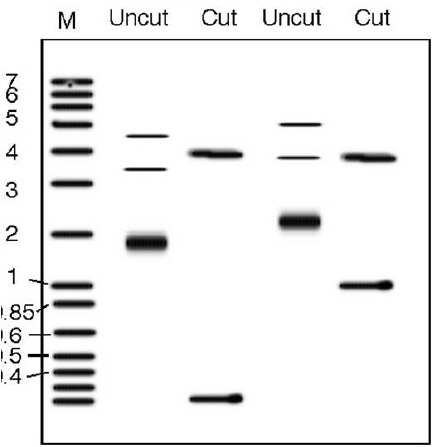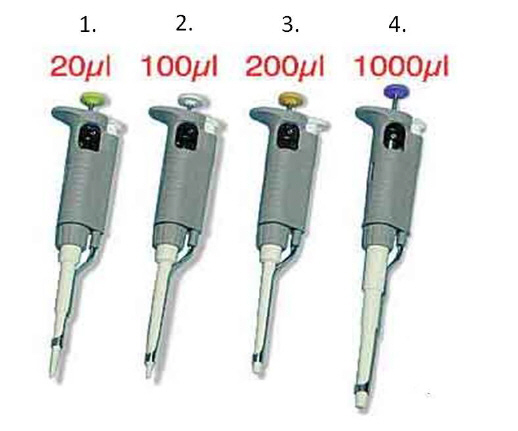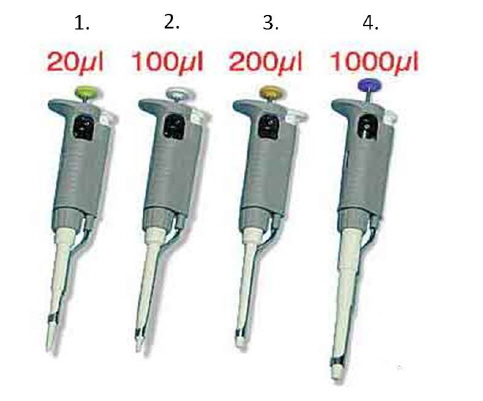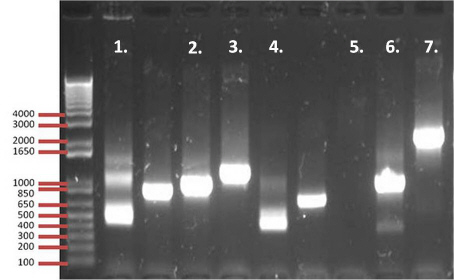Multiple Choice
Identify the
choice that best completes the statement or answers the question.
|
|
|
|
|
|
1.
|
The process illustrated in the above diagram is
----
a. | transformation- bacterial cell are induced to uptake a new
plasmid. | d. | asexual reproduction- bacterial cells are replicating and
dividing | b. | transillumination- bacterial cells are made competent.
| e. | sexual reproduction- bacterial cells are exchanging genes. | c. | horizontal transfer of genetic material between bacterial
cells. |
|
|
|
The following questions refer the series of diagrams below.
Numbers 1, 3, and 5 refer to the structures in the diagram. Number 2, 4, and 6 refer to step in the
process of restriction digest of a plasmid
|
|
|
2.
|
How many restriction enzymes are required for the digest of
the plasmid reaction and uptake of the insert to be sucessful? How many restriction sites are
necessary?
a. | 1 restriction enzyme......1 restriction
site | b. | 2 different restriction enzymes......1 restriction site- This
could work if a selectable marker gene is present on the plasmid | c. | 3 different restriction enzymes.....1 restriction site- this could work but only if the
fragments created were of the same size. | d. | 2 different restriction
enzymes.....2 different restriction sites- but the sites must be close
together. | e. | both A and D could have worked with this
example |
|
|
|
3.
|
The step between 3 and 4 on the diagram shows an opened
plasmid. Which statement best describes how the plasmid was opened?
a. | restriction digest with restriction
enzymes | b. | PCR- polymerase chain reaction | c. | mini prep- to remove the plasmid | d. | reverse
transcriptase | e. | none of the
above |
|
|
|
The following gel show a lane of marker ladder then one
plasmid with uncut and cut lanes and a second, different plasmid also with an uncut and cut
lane. The extra band in the uncut lanes are the plasmid in slightly different forms-
supercoiled and nicked.

|
|
|
4.
|
Which are logical conclusions from the first set of Uncut
and Cut lanes based on the observable bands in the gel?
a. | There is no insert. The smallest fragment in the cut lane is
extra space where the PCR primers amplify the backbone. | b. | There is a large insert approximately 4000 bases in size. The smallest fragment
in the cut lane is primer dimer | c. | There is small insert of
less then 100 base not visible on the gel. The small visible fragment in the cut lane is the primer
dimer | d. | There is contamination and no evidence of a successful digestion
is visible. | e. | There is an internal
restriction site on the insert. |
|
|
|
5.
|
Compare both CUT lanes on the gel. The explanation for the
large bands at 4,000 bases is best described by which of the following?
a. | both bands are approximately 2,000 bases
long. | b. | Both bands are are uncut, whole
plasmid | c. | Both bands are evidence of contamination
| d. | Both bands show that the “inserts” are of the same
size | e. | Both bands are vector backbone from the original
plasmid |
|
|
|
|
|
|
6.
|
Observe clone number 1. Which observation(s) can be
made about the gel electrophoresis of this clone?
a. | The clone has an insert of approximately 300 base pairs.(+/-
50 bases) | b. | The clone shows
contamination- most likely from picking two colonies from the plate that were two close
together. | c. | The clone shows a PCR product of approximately 500 bases.
| d. | The digest lane and the PCR lane “agree” about the
size of the insert. | e. | Both a and d are
correct |
|
|
|
7.
|
Consider clone number 4. Compare the cut and the PCR
lanes. What are possible observations regarding this clone?
a. | There is single large insert with and an internal restriction
site on the insert. | b. | There is a single large
insert | c. | There is contamination- the PCR lane confirms this with two
different sized fragments | d. | There is a single large
insert and primer dimer in the cut lanes | e. | bothe a and d are
correct |
|
|
|
|
|
|
8.
|
The above image shows a plasmid (with no insert) digest
with Ava I enzyme on three different plasmids.
Which of the following explanation best describes
the results observed from the gel.
a. | Lane 1 shows a plasmid with possibly one cut
site | b. | Lane 1 shows a plasmid with two possible cut
sites | c. | Lane 2 shows a digest with two cut
sites | d. | Lane 3 shows a plasmid with three cut
sites | e. | All of the above are
correct |
|
|
|
Pipettor Practice:

|
|
|
9.
|
Which of the following should be used for pipetting
183.4ul?
a. | 1 only | b. | 2 and
3 | c. | 3 only | d. | 3 and
4 | e. | 4 only |
|
|
|
Pipettor Window:


|
|
|
10.
|
Which of pipettor would be ideal for pipette volume
#6
a. | 1 | b. | 2 | c. | 3 | d. | 4 | e. | none of the
above |
|
|
|
11.
|
Which pipettor would be ideal to pipette volume
#5?
a. | 1 | b. | 2 | c. | 3 | d. | 4 | e. | none of the
above |
|
|
|
2
|
|
|
12.
|
Which lane has the biggest insert?
|
|
|
13.
|
Which lane shows the smallest insert?
|
|
|
14.
|
Lane five can best described as a ---
a. | failed PCR reaction | b. | a failed restriction digest | c. | a poor mini
prep | d. | both a and c | e. | all a, b, and c |
|
|
|
15.
|
Which of the following could be an incorrect
statement?
a. | Lane 5 possibly forgot to add primers | b. | Lane1 had a succesful PCR and alot of template DNA in the
reaction. | c. | Lane 2’s insert is about 500 bases
long | d. | The fragment in lane 7 is about 2000 bp
long | e. | The results of lane 4 show an insert of about 200
bases |
|
|
|
|
|
|
16.
|
Which lanes show a restriction digest?
a. | Lanes 1, 2, 3 and 4 all show the products of a restriction
digest. | b. | Lane 1, 3, 5 al show the products of a restriction
digest | c. | Lane 2, 4, and 6 all show the products of a restriction
digest | d. | All the lanes show a restriction
digest | e. | None of the lane show a restriction
digest |
|
|
|
17.
|
Which the correct explanation for the bands in the lane
labeled 1?
a. | Contamination of mutiple plasmids | b. | Whoever made the reaction forgot to add primers | c. | There is an unut plasmid but it is running in three different
forms. | d. | There is a restriction digest with several fragments due to the
digest | e. | No DNA |
|
|
|
18.
|
What is the best explanation for lane 4?
a. | Uncut plasmid running in multiple
forms | b. | Internal restriction site in the cDNA | c. | too much DNA that is smearing in the lane | d. | forgot to add primers | e. | all of the above are
possible |
|
|
|
|
|
|
19.
|
Assuming a successful transformation of each plasmid into a
bacterial cell. Which will allow the bacterial cell to grow on a plate of LB only?
a. | the cell with plasmid 1 will not grow since it does not have
insert | b. | the cell with plasmid 2 will grow since there is a cDNA
present | c. | Both types of cell (one with plasmid 1 and the other with plasmid
2) will grow since there is no selection pressure on the plate | d. | All cells, regardless of whether they picked up the plasmid will grow since there is no
amp in the plate.
| e. | Both C and D are
correct |
|
|
|
20.
|
When using gel electrophoresis, which of the following is
FALSE?
a. | Fragments will separate by size; the largest fragments will move
the least | b. | the sample will migrate through an agarose
gel | c. | the higher the voltage the faster the sample will move through
the gel | d. | DNA is a negatively charged particle so it will need to be away
from the RED or + end | e. | All of the above are
true | f. | All of the above are false |
|